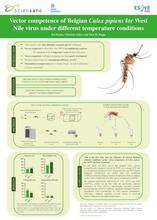An increased circulation of West Nile virus (WNV) has been reported in Europe during the last decade. Although there have thus far been no reported cases of WNV infections in Belgium, several neighboring countries reported WNV cases in animals and humans, making risk assessments of high importance with regard to a preparedness plan. Therefore, we determined the vector competence of field-collected Culex pipiens mosquitoes for WNV. This species could significantly contribute to WNV transmission upon an introduction of the virus due to their proven competence in other countries. Mosquitoes were exposed to a blood meal containing 7.13 x 107 PFU/mL WNV (strain Israel 98, lineage 1) and incubated for 14 days at a constant temperature of 25°C or at a 25/15°C day/night temperature gradient. All mosquitoes were kept at 80% relative humidity, and 16L:8D cycle. Subsequently, infection rate (IR), dissemination rate (DR) and transmission rate (TR) were determined by detection of viral RNA via RT-qPCR in abdomen, head-wings-legs and saliva, respectively. Results indicated that Culex pipiens exhibited an IR of 27.8%, DR of 53.3%, and TR of 50% at a constant 25°C. At the 25/15°C condition, the observed IR, DR an TR were 33.3%, 76.5% and 30.8%, respectively. These findings suggest that Culex pipiens mosquitoes are competent vectors for WNV at 25°C and at 25/15°C, with overall transmission efficiencies of 7.4% and 7.8%, respectively. Virus isolations are ongoing to confirm the presence of infectious virus in the collected samples while further investigations will explore the impact of climate change, reflected by a temperature gradient of 25/20°C, on vector competence. These efforts will provide valuable insights into the dynamics of WNV transmission and inform the development of effective preparedness and control strategies to mitigate the risk of WNV outbreaks in Belgium.



